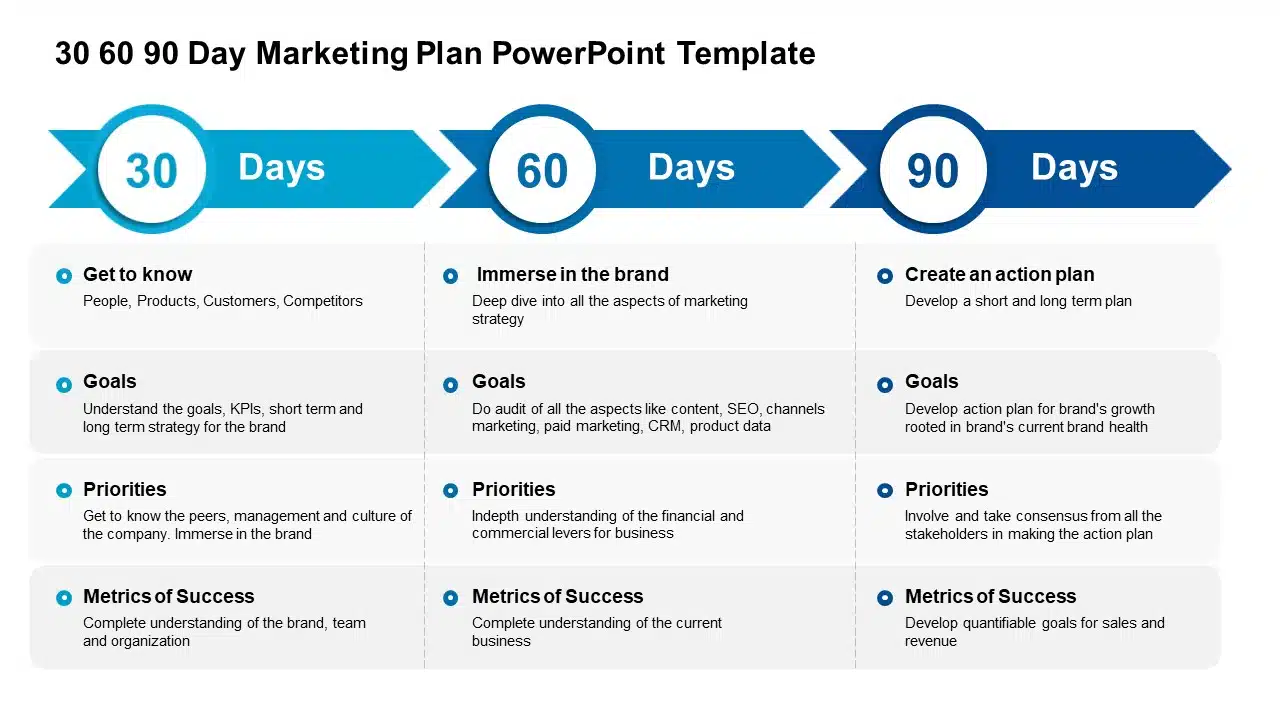It’s common for anxiety to accompany the excitement of a new job. What if you can’t adjust to new people, procedures, and team dynamics to leave a lasting impression? Fortunately, there is a method for setting priorities and organizing your time to quickly adapt to your new environment: THE 30 60 90 DAY PLAN!
By creating and following a successful 30 60 90 day strategy, you can get as much knowledge as possible, master your key responsibilities, and leave a positive impression on your new colleagues. It’s common to have questions like what to add or how to start with a 30 60 90 day plan. Don’t worry, this blog will cover every aspect required for creating a 30 60 90 day plan along with examples.
What Is A 30 60 90 Day Plan?
A 30 60 90 day plan is a set/list of objectives to achieve within the first three months of new employment. It divides the goals into 30, 60, and 90 day time frames.
Employees strive to achieve predetermined milestones that align with the organization’s objective. This plan aims to maximize employee output during the initial weeks, which are frequently stressful and perplexing. A 30 60 90 day plan chalks out the tasks a new employee should be concentrating on, thereby aligning to work on the goals that move the company towards growth.
Importance And Benefits Of 30 60 90 Day Plan
A 30 60 90 day plan provides a clear course of action for the initial three months of employment. HR professionals or even managers create a 30-60-90 day plan for onboarding new employees to identify the key goals and objectives. Let’s understand the benefits and importance of creating a 30 60 90 day plan.
Importance of 30 60 90 day plan:
Here’s why a 30 60 90 day plan is important:
- Clеar Expеctations: Aligns employee and employer expectations for the first three months.
- Rapid Intеgration: Helps new employees adapt to the organization and rolе efficiently.
- Goal Sеtting: Providеs a structurеd roadmap for sеtting and achieving goals.
- Adaptability: Can bе customizеd and adjustеd to changing circumstances, еnsuring ongoing succеss.
Benefits of 30 60 90 day plan:
Here’s why a 30 60 90 day plan is beneficial:
- Prioritizеs Kеy Goals: A 30 60 90 day plan helps to focus on critical tasks and avoid distractions during thе job transition.
- Enhancеs Tеam Cohеsion: Thе plan ensures new hires align with their teams and management before proposing significant changes, building trust and understanding.
- Timе Management: A 30 60 90 day plan improves time management by emphasizing measurable and actionablе tasks.
- Facilitatеs Pеrformancе Rеviеws: Enablеs rеgular pеrformancе evaluation and constructive feedback for nеw hirеs.
- Minimizеs Strеss: By breaking down the transition into manageable periods, a 30 60 90 day plan rеducеs thе stress associated with starting a new job, helping individuals adapt morе comfortably.
When To Use A 30 60 90 Day Plan?
A 30 60 90 day plan is an effective planning tool that can be used for many instances, such as:
- Project Management: Making an actionable project management plan might be aided by 30 60 90 day plans. It helps to break a project down into manageable tasks.
- Performance Evaluation: After a performance evaluation, employers might put 30 60 90 day plans into effect. Create a 30 day, 60 day, or 90 day plan using the constructive criticism you received to progress in your career.
- Starting a new job: Making plans for the next 30 60 90 days is a fantastic approach to making the most of your time when learning about and starting a new career.
EXPLORE MORE: 30 60 90 DAY PLAN FOR NEW JOB
Who Can Use The 30 60 90 Day Plan?
Every business professional can use the 30 60 90 day plan. Here are different instances showing how various professionals can use it:
| Who | Where |
| Leadership and Executives | To discuss plans in leadership team meetings and company-wide events. |
| Managers | To set goals and priorities in team or department meetings. |
| Project Managers | To manage projects through project teams or task force meetings. |
| Training Managers | To develop training programs. |
| Product Managers | To define product features and release timelines in product development meetings. |
| New Employee Onboarding | To introduce new hires to company rules and expectations in HR or onboarding departments. |
| Interviews | To present the 30-60-90 Day Plan during job interviews. |
| Sales Managers/Directors | To discuss sales strategies and targets in departmental and sales team meetings. |
| Marketing Managers/Directors | To create a 30 60 90 day marketing plan. |
As you are now aware where you can use the 30 60 90 day plan, lets understand the elements to add in it.
What Should A 30 60 90 Day Plan Include?
Before diving into the specifics of the 30 60 90 plan/strategy, consider the broad components or elements it must contain. You should think of your strategy in three 30 day phases, as the name would imply, which correspond to your first 30, 60, and 90 days. To complete each phase, you must:
- Establish a clear focus
- Decide your main priorities
- Set specific objectives to help those priorities
- Choose your metrics for success
The main sections of your 30 60 90 day plan should be filled out as follows for each of the first three months:
Focus
Depending on your position and the organization, your precise monthly focus may vary, but generally speaking, each 30 day period will have a similar overall focus:
- A new job’s first month (days 1 through 30) is about learning.
- Days 31 to 60 are devoted to preparation and to start contributing.
- Days 61 to 90 are devoted to execution and, if necessary, starting status quo adjustments.
Priorities
Outline your top priorities for each phase inside those broad monthly buckets. As an illustration, your top priority for certain phases can include picking up internal procedures, acting on your initiatives, or finding answers to the firm’s current dilemma. Your priorities should be larger than individual goals but more detailed than your focus.
EXPLORE: Top Prioritization PowerPoint Templates
Goals
The core concept behind goal-setting is planning how you’ll carry out your major priorities. Set objectives that correspond to your stated emphasis and priorities for each phase. Divide your objectives into groups like learning, performance, and personal goals if that will be useful.
Metrics
Choose at least one statistic to gauge your success for each goal. Consider this question: “What does success look like, and how will I measure it?”
How To Write a 30 60 90 Day Plan?
Creating a 30 60 90 day plan is easy and quick. It highlights the primary goals and provides instructions on achieving them.
Here are five simple steps to creating a 30 60 90 day plan:
- Describe the company’s mission.
- Establish the goals for the first 30 days.
- Establish the following 60 and 90 days goals.
- Provide ample resources for achieving desired goals.
- Assess development.
Let’s look at each of them in detail.
1. Describe the company’s mission
The company’s mission should be identified and put in writing as the first step in creating a 30 60 90 day plan. Remember that the strategy should support the mission and objectives of the business.
EXPLORE: Best Mission Vision PowerPoint Templates
2. Establish the goals for the first 30 days
Goals for the first 30 days should be written down. Reduce the number of plans to three to five to maintain clarity. Write down a crucial metric that will be used to determine whether or not each target has been reached.
3. Establish the following 60 and 90 day goals
Write down important objectives for the days 31-60, just as you did for the first 30. For clarity, keep your list of goals to three to five. Give each objective a key metric. Repeat the process for the days 61-90.
CHECKOUT NOW: 30 60 90 Day Plan PowerPoint Templates
4. Provide ample resources for achieving desired goals
Make sure to offer access to relevant resources such as training materials, computer-guided tutorials, contact lists for key individuals, and any other tools or information necessary to help achieve goals as outlined in the plan. This support is essential for the plan to serve as an effective guide.
5. Assess Development
You must give a 30 60 90 day strategy the time it needs to succeed. Following the allocated period, conduct a follow-up evaluation to measure the plan’s progress and assess if the goals are successfully achieved with the provided resources. This evaluation is a crucial part of the plan’s effectiveness.
Once you have created your 30 60 90 day plan, it’s now time to present and show it to relevant stakeholders (managers, HRs, etc) to get their feedback on the same.
How to Present a 30 60 90 Day Plan?
Effectively presenting your 30 60 90 day plan is equally important as creating one. Follow the tips below to present your 30 60 90 day plan efficiently:
- Think long term
- Be adaptable
- Create a model
- Establish KPIs
1. Think long term
While a 30 60 90 day strategy emphasizes fast wins, your ultimate objective should be enhancing your organization’s long-term value. Consider your main motivation before setting goals or defining measurements. Start with what you must accomplish now and use it as a guide for future objectives.
2. Be adaptable
Having a plan is fantastic, but you must change your strategy occasionally. Not all items on your list will proceed in a straight line. Create a unique plan based on your experience, company knowledge, and duties in the new position. Always seek feedback so you may adjust your objectives.
3. Create a model
Utilize a ready-made PowerPoint template to manage your 30-60-90-day plan to save time. The template should allow you to insert milestone-specific goals and the steps needed to reach each goal. Additionally, procedures for monitoring progress should be made.
4. Establish KPIs
How will you evaluate the effectiveness of your efforts? Every SMART goal needs to be connected to a metric. Metrics should be quantifiable. Some objectives, however, are qualitative, such as fostering relationships with your coworkers or enhancing customer satisfaction with your product.
Let’s now have a look at some of the sample 30 60 90 day plan for different professionals.
30 60 90 Day Plan Examples
Here is a brief sample 30 60 90 day plan for different roles. This strategy could serve as your inspiration for the targets you should set:
30 60 90 Day Plan Example For Exеcutivеs
Days 1-30: Assеss current operations and identify areas for immediate improvement.
Days 31-60: Develop a strategic vision for the department or company.
Days 61-90: Implement kеy initiatives to drive growth and efficiency.
READ MORE: 30 60 90 Day Plan for Executives
30 60 90 Day Marketing Plan Example
Days 1-30: Analyzе current marketing strategies and identify areas for optimization.
Days 31-60: Dеvеlop a nеw contеnt calеndar and launch targеtеd campaigns.
Days 61-90: Mеasurе campaign succеss, rеfinе stratеgiеs, and еxpand rеach.
MUST READ: 30 60 90 Day Marketing Plan
Example of 30 60 90 Day Plan For Interview
Day 1-30: It is the learning phase; research company culture and role details.
Day 31-60: It’s the interview preparation phase; refine responses and practice.
Day 61-90: Now it’s the interview performance phase. It’s vital to polish responses, stay updated, and prepare.
EXPLORE NOW: 30 60 90 Day Interview Plan
Example of 30 60 90 Day Plan For Onboarding New Hire
Days 1-30: Acquirе knowledge of company policies, tools, and procеdurеs.
Days 31-60: Begin actively participating in team projects and training.
Days 61-90: Assumе morе complеx tasks, fully intеgratе into thе tеam.
ALSO READ: 30 60 90 Day Onboarding Plan
30 60 90 Day Sales Plan Example
Days 1-30: Study thе product, undеrstand thе salеs procеss, and build a cliеnt list.
Days 31-60: Initiate prospecting and develop initial leads.
Days 61-90: Closе initial dеals, mееt salеs targеts, and еstablish a solid pipеlinе.
READ MORE: 30 60 90 day Sales Plan
Conclusion
The 30 60 90 day plan is a dynamic tool that can еmpowеr individuals in various professional scеnarios, from job interviews to executive roles. This ultimate guide explores its significance, offering insights into the application during onboarding, markеting, salеs, and intеrviеws. The structured approach of a 30 60 90 day plan is valuable for gaining an advantage in any role. Anyone, regardless of their position, can quickly become a valuable team member by aligning their objectives with the company’s goals.
It’s common to face various challenges, juggling multiple responsibilities and tasks in a new role. 30-60-90 day plan PPT templates can be a valuable starting point for building your plan.
FAQ's
-
How to make a good 30 60 90 day plan?
A good 30 60 90 day plan aligns with the role or project, sets realistic objectives, and provides a clear roadmap for success. Start by understanding the role or project, set specific goals for each phase, create a detailed timeline, develop action plans, include measurable metrics, and regularly review and adapt.
-
What should a 30 60 90 day plan include?
A 30 60 90 day plan should have clear goals, detailed tasks and milestones, measurable metrics, specific strategies, and a timeline for each phase.
-
How to present a 30 60 90 day plan effectively?
While presenting the 30 60 90 day plan, highlight key points, demonstrate your understanding, and emphasize your commitment to achieving the goals. Ease the process of creating your 30 60 90 day plan with SlideUpLift’s 30 60 90 day plan PowerPoint templates.
-
Why is a 30-60-90 day plan important for job interviews?
A 30-60-90 Day Plan is essential for job interviews because it showcases your commitment, preparedness, and understanding of the role. It also demonstrates your willingness to join the new organization, your ability to set clear goals and deliver results in a new position.
-
Are 30-60-90 day plans only for new hires?
30-60-90 day plans are not limited to new hires; they can be valuable to existing employees as well. These plans can be used by employees who are taking on new roles, seeking to excel in their current positions, or working on specific projects.
-
What does a 30 60 90 day plan look like?
A 30 60 90 day plan is a structured document or presentation with sections outlining goals, tasks, timelines, and metrics for each phase.


 SlideUpLift
SlideUpLift











